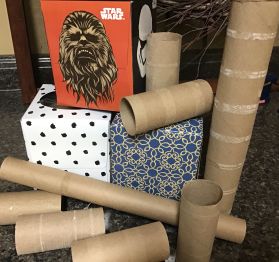
Toys purchased from stores can be expensive only to have children play with them for a brief period of time before setting them aside for something else. Empty boxes and containers, on the other hand, make great toys and allow for way more imagination and creativity. Better yet, they don’t cost you anything extra as you were probably going to recycle them anyway! Let students learn about the value of cardboard toys as they explore and engage in the following lesson.
Set
- Using the information from the article titled “5 Best Toys of Time“, I ask students to generate a list of what they believe to be the five best toys of all time.
- Students share and most of what they are sharing are store bought toys so I ask them what the following items have in common: Dirt, Box, Stick, String and Cardboard Tube.
- After we talk about what they have in common, I ask students how many of them played with these items when they were children. Those that did briefly share how.
Materials
- iPads or Laptops
- Screen & Projector
- Empty Tissue Cubes
- Empty Toilet/Paper Tubes
- Glue, String, Tape, etc.
- Art Supplies (paint, markers, scissors, embellishments)
Activities
- Share the story via YouTube “Not a Box” and show them how a box and creativity were combined in this Dorito commercial.
- Assign the article What Children Can Learn From a Cardboard Box and have them complete the Thinking at Right Angles graphic organizer as they read.
- Introduce students to the Cubes & Tubes Project. Provide each student or team with string, a variety of cardboard objects (empty tube: paper towel, wrapping paper or toilet paper & tissue box cube, small boxes, etc.) and basic art supplies that they must develop and create into a creative toy, game, or activity for children. (This is a smaller version of the cardboard challenge.)
- Rules: A variety of containers and/or objects must be used. In addition, other “open- ended objects, embellishments and art & craft resources may be utilized in the making of this project. Items may be brought from home to make your creation playable, but please discuss your ideas with your teacher first as we want to keep creativity as authentic as possible.
- In addition, you must name your creation, provide a write -up describing how children can play with it and what they might learn or develop by doing so. If working as a team, you must also complete a Group Project Peer Evaluation (TPT freebie) for your group members.
- Finally, students must share their creation in an oral presentation, explaining and demonstrating its function and purpose.
Attachments
- Thinking At Right Angles (PDF)
- Cubes & Tubes Project (PDF)

